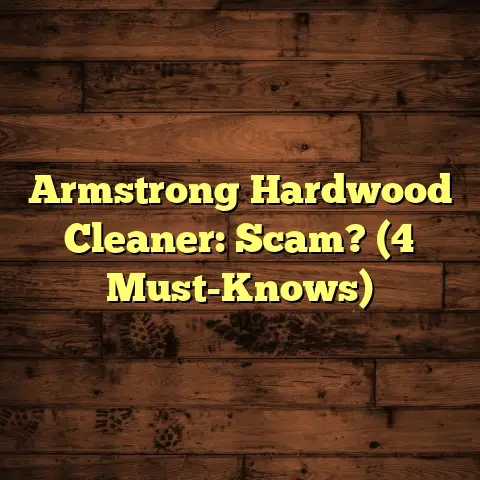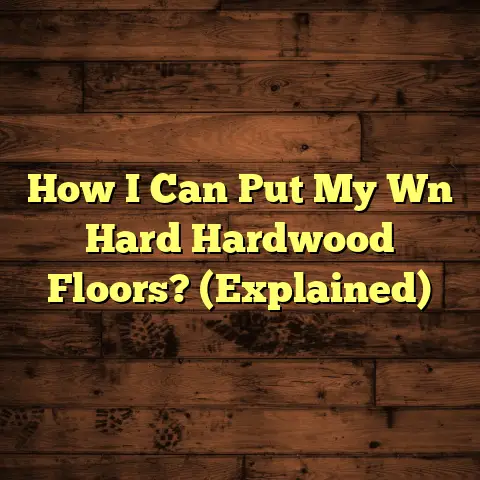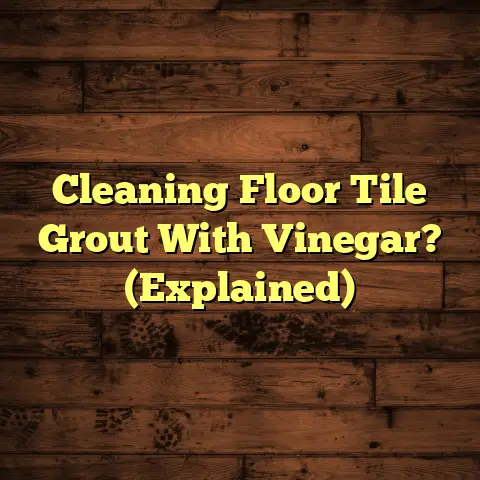Vinegar on Wood Floors? (1 Pro Warns: DON’T!)
Let’s talk about something near and dear to my heart:
Your beautiful wood floors.
I’ve seen it all in my years as a flooring contractor –
the good, the bad, and the downright ugly.
And trust me, when it comes to wood floor maintenance,
a little knowledge goes a long way.
You might think keeping those floors gleaming is a chore,
but honestly, it’s easier than you think.
And it’s so worth it!
After all, your floors are the foundation of your home’s style.
Now, I want to address something I hear ALL the time:
Vinegar.
Yep, that seemingly harmless household staple.
It’s touted as a natural cleaner for everything,
but is it really safe for your precious wood floors?
Well, let me tell you, as a seasoned pro,
I’ve got a cautionary tale for you.
Spoiler alert:
Vinegar and wood floors?
Not always the best combo.
Stick with me, and I’ll explain why,
plus give you some killer alternatives
to keep your floors looking their best.
Section 1: Understanding Wood Floors
Okay, let’s start with the basics.
Not all wood floors are created equal.
And understanding the type you have is crucial
for choosing the right cleaning methods.
Types of Wood Flooring
Let’s break down the most common types:
-
Solid Hardwood:
This is the real deal.
Think classic oak, maple, or walnut planks.
It’s durable, beautiful, and can be refinished
multiple times, making it a long-term investment.
But, it’s also susceptible to moisture damage.
-
Engineered Wood:
This is made of layers of plywood or high-density fiberboard
with a veneer of real wood on top.
It’s more stable than solid hardwood
and can handle humidity fluctuations better.
However, the veneer layer means you can only
refinish it a limited number of times, if at all.
-
Laminate:
Okay, this isn’t technically wood.
It’s a synthetic material designed to look like wood.
It’s affordable, scratch-resistant, and easy to install.
But it’s not as authentic as real wood
and can’t be refinished.
Each of these flooring types reacts differently
to various cleaning agents.
What works wonders on laminate could be disastrous
for solid hardwood.
Importance of Proper Maintenance
Why bother with all this cleaning fuss?
Well, for starters, it keeps your floors looking gorgeous.
But it’s about more than just aesthetics.
-
Durability:
Regular cleaning removes dirt and grit
that can scratch and wear down the finish.
Proper maintenance extends the life of your floors,
saving you money in the long run.
-
Hygiene:
Floors are magnets for dust, allergens, and bacteria.
Cleaning helps create a healthier living environment
for you and your family.
-
Value:
Well-maintained wood floors increase the value of your home.
They’re a major selling point for potential buyers.
I’ve seen houses where neglected floors drastically
lowered the property value.
Don’t let that happen to you!
Common Cleaning Methods
So, what are some safe and effective ways
to clean your wood floors?
Here are a few general guidelines:
-
Sweep or Vacuum Regularly:
This is the most important step!
Remove loose dirt and debris daily or every other day.
Use a soft-bristled broom or a vacuum
with a floor brush attachment to avoid scratching.
-
Damp Mop (Carefully!):
Never soak your wood floors.
Excess water can seep into the wood
and cause warping or staining.
Use a microfiber mop dampened with a wood floor cleaner.
Wring it out thoroughly so it’s barely damp.
-
Use a Wood Floor Cleaner:
Choose a cleaner specifically designed for wood floors.
Avoid harsh chemicals, abrasive cleaners, or anything
containing ammonia or bleach.
-
Spot Clean Spills Immediately:
Don’t let spills sit!
Blot them up with a clean, dry cloth as soon as possible.
For sticky spills, use a damp cloth and a mild cleaner.
These basic methods will go a long way
in keeping your wood floors in tip-top shape.
Section 2: The Role of Vinegar in Cleaning
Now, let’s dive into the main topic: Vinegar!
It’s a staple in many households,
often hailed as a natural cleaning wonder.
But is it really all it’s cracked up to be?
What is Vinegar?
Vinegar is basically diluted acetic acid,
typically around 5-8% concentration.
It’s produced through the fermentation of ethanol
by acetic acid bacteria.
Sounds complicated, right?
Basically, it’s made from things like apples, grapes, or grains,
and then fermented to create that tangy liquid we all know.
Vinegar’s Cleaning Properties
So, why is vinegar so popular as a cleaner?
Well, it has a few key properties:
-
Acidity:
The acidity of vinegar helps to dissolve
mineral deposits, grease, and grime.
-
Antibacterial:
Vinegar has some antibacterial properties,
making it effective for killing certain germs and bacteria.
A study published in the “Journal of Environmental Health”
found that vinegar can be effective against
some common household pathogens.
-
Deodorizing:
Vinegar can help neutralize odors,
leaving your home smelling fresh.
Common Uses of Vinegar in Households
People use vinegar for all sorts of cleaning tasks:
-
Cleaning Countertops:
Vinegar can be used to clean kitchen and bathroom countertops.
-
Descaling Coffee Makers:
It’s effective for removing mineral buildup in coffee makers.
-
Cleaning Windows:
Vinegar can leave windows sparkling clean.
-
Laundry:
Some people use vinegar as a laundry booster
to remove stains and odors.
Given its versatility and natural appeal,
it’s no wonder people are tempted to use vinegar
on their wood floors.
But hold on tight, because here’s where things get tricky.
Section 3: The Flooring Pro’s Warning
Alright, time for the truth bomb.
As a flooring professional with years of experience,
I’ve seen firsthand the damage that vinegar can inflict
on wood floors.
Introduction to the Expert
Let me tell you a bit about myself.
for over [Number] years.
I’ve installed, repaired, and refinished countless wood floors,
from historic homes to modern condos.
I’ve worked with every type of wood flooring imaginable,
and I’ve seen just about every cleaning mistake in the book.
I am certified by [Relevant Organization] and stay updated
with industry best practices through continued education.
The Warning Against Vinegar
Here’s the thing:
While vinegar’s acidity is great for some cleaning tasks,
it can be detrimental to wood floor finishes.
-
Damages Finishes:
The acetic acid in vinegar can break down
the protective finish on your wood floors,
making them appear dull and worn over time.
This is especially true for polyurethane finishes,
which are commonly used on wood floors.
-
Causes Discoloration:
Vinegar can also cause discoloration,
especially on darker wood floors.
It can lighten the wood or create a cloudy appearance.
-
Leads to Long-Term Deterioration:
Over time, repeated use of vinegar can strip away
the finish completely, leaving the wood exposed
to moisture and damage.
This can lead to warping, cracking, and staining.
I always tell my clients, “Think of your floor finish
like a protective shield. Vinegar is like a little acid rain
that slowly eats away at that shield.”
Real-Life Examples
Let me share a couple of stories from my own experience:
-
The Dull Oak Floors:
I had a client who had been using a vinegar and water solution
to clean her oak floors for years.
She couldn’t figure out why they looked so dull and lifeless.
When I inspected the floors, I found that the finish
had been completely eroded by the vinegar.
The only solution was to refinish the entire floor,
which was a costly and time-consuming project.
-
The Cloudy Maple Floors:
Another client had beautiful maple floors
that had developed a cloudy, hazy appearance.
She had been using vinegar to remove stubborn stains.
Unfortunately, the vinegar had damaged the finish
and caused discoloration.
We were able to partially restore the floors,
but they never looked quite as good as they did originally.
These are just two examples of the damage
I’ve seen caused by vinegar.
Trust me, it’s not worth the risk!
Section 4: Alternative Cleaning Solutions
Okay, so vinegar is a no-go.
But what can you use to clean your wood floors safely
and effectively?
Don’t worry, I’ve got you covered!
Safe Cleaning Alternatives
Here are some of my favorite alternatives:
-
Wood Floor Cleaners:
These are specifically formulated for wood floors
and are designed to clean without damaging the finish.
Look for pH-neutral cleaners that are free of harsh chemicals.
Some popular brands include Bona, Murphy Oil Soap (used sparingly!),
and Method.
-
Steam Mops (Use with Caution!):
Some steam mops are designed for wood floors,
but it’s crucial to use them correctly.
Make sure the mop is set to the lowest steam setting
and that the mop pad is damp, not soaking wet.
Never let the steam linger in one spot,
as this can cause moisture damage.
-
Microfiber Mops:
These mops are excellent for dry and damp cleaning.
The microfiber material traps dirt and dust
without scratching the floor.
DIY Cleaning Solutions
If you prefer a more natural approach,
here are a couple of DIY cleaning solutions that are safe
for wood floors:
-
Mild Soap and Water:
Mix a few drops of mild dish soap (like Dawn)
with warm water.
Dampen a microfiber mop with the solution
and wring it out thoroughly.
Wipe the floors and then dry them with a clean cloth.
-
Rubbing Alcohol and Water:
Mix 1/4 cup of rubbing alcohol with 1 quart of water.
This solution is great for removing stubborn stains
and grease.
Dampen a microfiber mop with the solution
and wring it out thoroughly.
Wipe the floors and then dry them with a clean cloth.
Comparative Analysis
Let’s compare these alternatives to vinegar:
| Cleaning Solution | Effectiveness | Safety for Wood Floors | Cost |
|---|---|---|---|
| Vinegar | Moderate | Low | Very Low |
| Wood Floor Cleaners | High | High | Moderate |
| Steam Mops | High | Moderate (if used correctly) | Moderate to High |
| Microfiber Mops | Moderate | High | Low |
| Mild Soap and Water | Moderate | High | Very Low |
| Rubbing Alcohol & Water | High | Moderate | Low |
As you can see, while vinegar may be cheap and readily available,
it’s not the safest option for your wood floors.
The other alternatives offer better cleaning power
without the risk of damage.
Section 5: Best Practices for Wood Floor Care
Alright, let’s wrap things up with some best practices
for keeping your wood floors looking their best.
Daily Maintenance Tips
-
Dust or Sweep Regularly:
This is the most important thing you can do!
Remove loose dirt and debris daily or every other day.
-
Use Doormats:
Place doormats at all entrances to trap dirt and moisture
before they reach your wood floors.
-
Protect Furniture Legs:
Attach felt pads to the bottom of furniture legs
to prevent scratches and dents.
-
Trim Pet Nails:
Keep your pet’s nails trimmed to minimize scratches.
Deep Cleaning Methods
-
How Often to Deep Clean:
Deep clean your wood floors every 1-2 months,
or more often if you have pets or heavy traffic.
-
Best Practices for Deep Cleaning:
Use a wood floor cleaner or a DIY solution
as described above.
Dampen a microfiber mop with the solution
and wring it out thoroughly.
Wipe the floors and then dry them with a clean cloth.
-
Avoid Over-Wetting:
Again, never soak your wood floors!
Excess water can cause warping and staining.
Seasonal Maintenance
-
Humidity Control:
Wood floors are sensitive to humidity fluctuations.
In the summer, use a dehumidifier to keep humidity levels
between 30-50%.
In the winter, use a humidifier to prevent the wood
from drying out and cracking.
-
Protect from Sunlight:
Prolonged exposure to direct sunlight can fade
and discolor wood floors.
Use curtains or blinds to protect your floors
from intense sunlight.
Conclusion
So, there you have it!
The truth about vinegar and wood floors.
While it may seem like a convenient and natural cleaning solution,
the risks outweigh the benefits.
As a flooring professional, I’ve seen firsthand
the damage that vinegar can cause.
I urge you to prioritize safe, effective cleaning solutions
that protect your investment in wood flooring.
Remember, your wood floors are a valuable asset
that can last for generations with proper care.
By following these tips and avoiding harsh chemicals like vinegar,
you can keep your floors looking beautiful
for years to come.
Happy cleaning!





